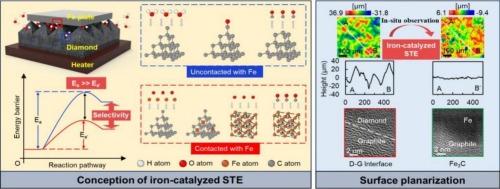铁催化选择性热化学蚀刻实现了多晶金刚石的平面化
IF 6.9
2区 材料科学
Q2 CHEMISTRY, PHYSICAL
引用次数: 0
摘要
提出了一种接触式铁催化选择性热化学蚀刻技术,用于聚晶金刚石(PCD)薄膜的表面平面化。在由C(金刚石)、Fe、O元素组成的加热系统中,与Fe接触的金刚石区域的热化学腐蚀比未与Fe接触的区域具有显著的优先性。由于这种明显的选择性,原位观察证实了PCD在1000、1050℃时优先去除与Fe板接触的金字塔状突起,从而实现了PCD的平面化。在PCD表面检测到Fe3C,亚稳Fe3C的分解导致石墨的生成,这是造成这种选择性的主要途径。利用多尺度模拟研究了原子尺度的选择性机理。铁元素降低了金刚石与O元素氧化反应的能垒,证明了铁催化热化学刻蚀的选择性。顶部与Fe原子接触区域的C原子通过在金刚石- Fe界面形成Fe3C被激活为非金刚石结构。由于形成突起的所有C原子同时浸入O原子中,与Fe原子接触的活化C原子被优先去除。本文章由计算机程序翻译,如有差异,请以英文原文为准。

Iron-catalyzed selective thermochemical etching achieves planarization of polycrystalline diamond
A contact iron-catalyzed selective thermochemical etching technique is proposed for surface planarization of polycrystalline diamond (PCD) films. In the heating system consisted of C (diamond), Fe, O elements, the thermochemical etching of diamond areas contacted with Fe exhibits significant priority compared to areas uncontacted with Fe. With such pronounced selectivity, the in-situ observations confirm that the planarization of PCD is realized with pyramid-shaped protrusions in contact with Fe plate preferentially removed at the temperature of 1000, 1050 ℃. Fe3C is detected on PCD surface and the decomposition of the metastable Fe3C leads to the generation of graphite, which is the major route causing this selectivity. The atomic-scale mechanism of selectivity is investigated using multi-scale simulations. The iron element reduced energy barrier for oxidation reaction of diamond with O element, proving the selectivity properties of iron-catalyzed thermochemical etching. C atoms at top areas contacted with Fe atoms are activated into non-diamond structure by forming Fe3C at diamond–Fe interface. As all the C atoms forming the protrusions are immersed in O atoms simultaneously, the activated C atoms contacted with Fe atoms were preferentially removed.
求助全文
通过发布文献求助,成功后即可免费获取论文全文。
去求助
来源期刊

Applied Surface Science
工程技术-材料科学:膜
CiteScore
12.50
自引率
7.50%
发文量
3393
审稿时长
67 days
期刊介绍:
Applied Surface Science covers topics contributing to a better understanding of surfaces, interfaces, nanostructures and their applications. The journal is concerned with scientific research on the atomic and molecular level of material properties determined with specific surface analytical techniques and/or computational methods, as well as the processing of such structures.
 求助内容:
求助内容: 应助结果提醒方式:
应助结果提醒方式:


